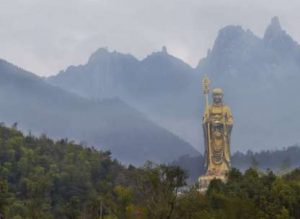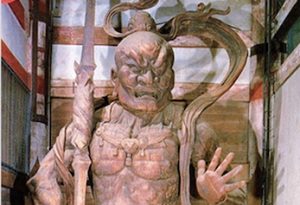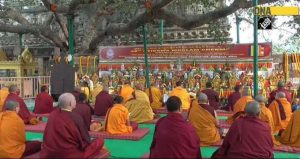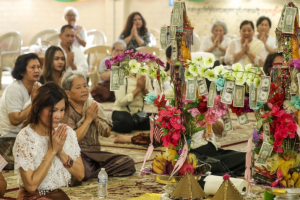
When I interviewed Dr. Stephanie Balkwill was exactly a decade ago, she shared the story of the Northern Wei’s unique role at the three-way intersection of Chinese history, Buddhist monasticism, and women’s courtly life. Her new book, The Women Who Ruled China: Buddhism, Multiculturalism, and Governance in the Sixth Century (2024) from California University Press, is the culmination of her research and writing on this subject. Here she brings to scholarly (and hopefully popular) attention a female Buddhist monarch on par with Wu Zetian: Empress Dowager Ling (d. 528 CE) of the Northern Wei (386–534). While Wu Zetian is positively celebrated in Luoyang and Xi’an these days, what with so many women’s historical dress-ups, performances about Wu, and official merchandise, Ling is far less known. But her reign is, by Stephanie’s analysis, far bloodier and more violent.
Her regency was from 515–20 and 525–28, with both periods marked by a Buddhist flourishing under Ling. The in-between half-decade of 520–25 gives some hint to the turbulence that also characterizes Ling’s tenure. Specifically, she had survived a coup in those years and staged a remarkable comeback to not only survive but to control the Northern Wei throne for another three years.
Although Balkwill describes Ling as Wu Zetian’s predecessor, Ling’s origins were much more epic, complete with a prophecy and a blood-red sky. The gallery of schemers, murderers, and backstabbers during this period reads like a medieval Chinese version of Game of Thrones. This was very much a product of imperial-Confucian patriarchy, and the fact that the fortunes and calamities of women were dependent on their relationships with the men of the court. (56–57) Ling herself was recommended to the harem of emperor Xuanwu (r. 499–515) by her aunt, Shi Sengzi. Sengzi was a Buddhist nun and one of the major protagonists of this study as a network builder of Buddhist women of the court and a manager of the monastic powers behind said imperial women. (101, 103)
In one of the bloodiest and vengeful episodes of Ling’s life, she was nearly assassinated by her rival, the official wife to the emperor, Empress Gao, before Gao was herself dispatched by Ling’s agents in 519. (3) Her craving for direct governance was almost Shakespearean, culminating in the murder of her own son and putting that man’s own daughter, her granddaughter, on the throne. (3) Her demise was just as violent and brutal. The end of her second regency and the date of her death intersect chillingly: she was drowned by enemy forces in Luoyang, even after having attempted to escape her adversaries’ crosshairs by retiring and becoming a nun.
We shall return to this apparently senseless act. But before we condemn Ling’s apparent bloodthirstiness and propensity for clinging to power, in a historical irony worthy of a George R. R. Martin twist, the toppling of this scheming climber led to the Northern Wei’s rapid decline and collapse. Ling was herself a weak ruler, (138) but the final years of the dynasty after her death were ruined by squabbling factions, civil decay, and institutional rot. Balkwill calls Ling the last independent ruler of the Northern Wei. Her death also led to the obliteration of the exalted position that the Buddhist sangha had enjoyed under her. Much like Cleopatra, whose salacious reputation we know more about than her actual historical personality, and who was the last independent leader of her beloved Egypt, Ling’s story, warts and all, needs revisiting.
Balkwill’s book goes beyond repeating the Confucian, anti-female, and anti-Buddhist narrative that obscures the complex character of Ling. We cannot address in full every section of the book, but each is most definitely insightful and eye-opening. Chapter 3 is extremely interesting as she analyzes the relationship between royal women and the monastic bhikshuni institution in the Northern Wei. Effectively, there was a new social role, the “elite Buddhist woman,” (5) which was deployed by Northern Wei royal women to access high society and social eminence. This then fed into a symbiotic relationship with the monastic community, which would in turn support the women’s political advancement.
By Balkwill’s own admission, Chapter 4 presents the most challenging proposition that Ling believed that there was a route to the legitimate accession of a woman to the throne—through Buddhist texts. I will devote the rest of this review to her fascinating and sophisticated argument. At its heart is the observation that women staffed the imperial Buddhist institution at the Northern Wei court in Luoyang. By certain logical connections between powerful political roles for Buddhist women, Buddhist sutras’ doctrinal justification for elite women to become powerful, and feminine gender performance as “honorary men” in the tradition of the Northern Wei’s ethnic Taghbach culture, (110) was it possible that Ling, as Buddhist regent, believed that the Buddhist ideals of kingship were open to being taken up by females?

After assembling textual evidence for how women had financial autonomy and executive authority in the sphere of Buddhist development—patronage of caves, commissioning art, building infrastructure—Balkwill argues that Taghbach culture had a unique practice of assigning male-sounding names to women that indicated a degree of leeway for them to act as men in certain situations. One example is two female secretaries in Ling’s court with honorary names evoking their closeness to the male gender. (115)
Such women in this social context, especially if they had no fathers, could effectively become “social men” in their circles. A woman was effectively, socially, a man if she was “unmarried,” “gender-ambiguous,” and “autonomous”—qualities that Sengzi and her acolytes had. As she builds her case, Balkwill invokes the most famous Northern Wei historical woman—she was not ethnically Han—who is today the most famous Disney crossdresser: Hua Mulan, whose name in Chinese might be feminine but in her native Tachbach tongue is actually masculine: “unicorn.” (117)
If gender constructs in the Northern Wei were more tied to social and family location rather than simply sexual organs, what ultimately pushed Ling to remove her son and put her granddaughter on the throne? Three particular Buddhist scriptures—the Sutra of the Woman (Silver Countenance), the Sutra on the Prophecy of Ksemavati, and the Sutra of Vimali—present the case that women, and by inference in the texts, women attached to courtly settings, have the potential for buddhahood. This buddhahood is the narrative climax or karmic destiny of several conditions that reflected the Northern Wei context: gender ambiguity, elite status, and proximity to masculinity.
All of this suggests that Ling, inspired by the Northern Wei identification with the bodhisattva Maitreya since the 490s, could have had millenarian instincts thanks to a possible connection to the Great Cloud Sutra. (135) In other words, Ling saw her granddaughter, the unnamed female emperor that she installed for only a few days, as an honorary male in Tachbach culture, suffused with Ling’s millenarian expectation of Maitreya being reborn in not only potentially a woman’s body, but in the heir apparent.
Chapter 5 brings this feverish pitch of Ling’s possible socio-religious fervor over her own granddaughter to a screeching halt by outlining the complex but definitive decimation of Buddhism after Ling’s assassination. The sorry state of the Buddhist institution’s hypocrisy, moral bankruptcy, and greed by that time seems to indicate that its collapse was deserved. (153–54) Ultimately, Ling was not as successful as her more famous later counterpart, Wu Zetian. Her attempt to establish herself and her granddaughter as Buddhist monarchs that could survive the impending collapse of their dynasty failed. Ultimately, no number of rituals or dramaturgy could withstand hungry, angry garrisons furious at their economic impoverishment. Ling was killed by these people, and Maitreya’s new age was not to be.
Balkwill’s case is historically responsible and thoroughly researched. All in all, her new book is a treasure trove of impactful research and compelling historical storytelling, culminating in Chapter 4’s powerful argument about Ling’s most mysterious and confusing political move. The Women Who Ruled China demonstrates the author’s mastery at critical history and constructing a plausible picture that reveals the full extent of imperial women with executive power in their social status as Buddhist laywomen. Empress Dowager Ling’s life and deeds are intimately bound up in Balkwill’s fascinating discussion of Northern Wei society and gender norms. This volume will be a delight for anyone wishing to discover something truly new about Buddhist women’s history in medieval China.
References
Balkwill, Stephanie. 2024. The Women Who Ruled China: Buddhism, Multiculturalism, and Governance in the Sixth Century. Berkeley: California University Press
Related features from BDG
Lords of the Steppe: “Hunters, Warriors, Spirits: Nomadic Art of North China” at The Indra and Harry Banga Gallery
Rediscovering the Women of Northern Wei with Stephanie Balkwill
Related blog posts from BDG Tea House
Vairocana: The Esoteric Sun Buddha along the Chinese Buddhist Silk Road














